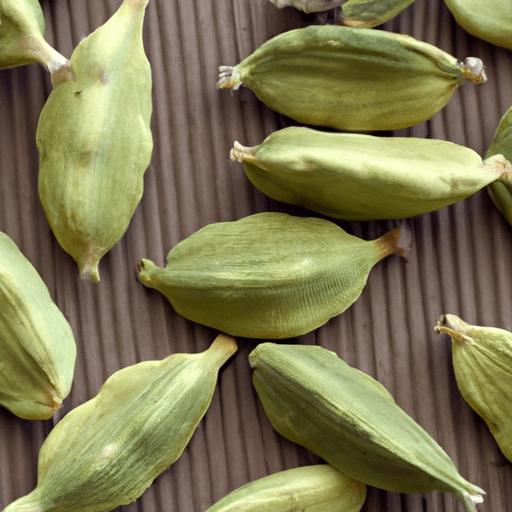Exploring the Aromatic World of Cardamom
If there’s one spice that can instantly transport your taste buds to exotic lands, it’s cardamom. This versatile spice has a rich history, a distinctive taste, and a myriad of culinary applications. Whether you’re a seasoned chef or an adventurous home cook, cardamom is a must-have in your pantry. In this blog post, we’ll dive into the mesmerizing world of cardamom, unraveling its flavors, exploring its uses, discussing its nutritional value, and sharing some fascinating facts along the way.
A Fragrant Flavor Explosion
Cardamom is known for its captivating aroma and unique flavor profile. It boasts a warm, sweet, and slightly citrusy taste, with hints of spice and floral undertones. Imagine the aroma of freshly brewed chai or the comforting scent of warm baked goods – that’s cardamom at work. Its distinct flavor adds depth and complexity to both sweet and savory dishes, making it a true culinary treasure.
Traditional and Adventurous Uses
Cardamom holds a special place in many traditional cuisines around the world. It is a key ingredient in Indian, Middle Eastern, and Scandinavian dishes, lending its magical touch to curries, desserts, beverages, and even pickles. In Indian cuisine, it’s often found in masalas and biryanis, infusing the dish with its enchanting flavor. Middle Eastern delicacies like baklava and Turkish coffee wouldn’t be the same without a sprinkle of cardamom. And in Scandinavia, cardamom is found in everything from cookies and pastries to meat dishes and mulled wine.
But cardamom is not limited to traditional recipes – it’s a spice that loves to experiment! It pairs wonderfully with chocolate, enhancing both its richness and sweetness. Try adding a pinch of ground cardamom to your next batch of brownies or truffles for a delightful twist. You can also infuse cardamom into syrups, jams, and ice creams for a flavorful treat.
Nutritional Goodness
Besides its incredible taste, cardamom brings some nutritional benefits to the table. It’s a good source of minerals such as potassium, calcium, and magnesium. These minerals contribute to overall heart and bone health. Cardamom also contains antioxidants, which help protect the body from harmful free radicals. Additionally, it’s been used for centuries in traditional medicine to aid digestion and soothe various ailments.
From Ancient Origins to Modern Day Wonder
Cardamom has a fascinating history that stretches back centuries. Originating in India, it was highly prized and traded along ancient spice routes that spanned continents. It eventually made its way to the Middle East, where it became an integral part of Arabic cuisine and traditional medicine. From there, it spread to Europe and other parts of the world. Today, it remains one of the most cherished spices in the culinary world, beloved for its unrivaled flavor and versatility.
Fascinating Facts About Cardamom
- There are two main types of cardamom: green and black. Green cardamom is more common and has a milder flavor, while black cardamom is smokier and has a more robust taste.
- In ancient Rome, cardamom was often used as a breath freshener and digestive aid.
- Cardamom seeds were chewed to help cleanse teeth and freshen breath long before toothbrushes and mint became popular.
- It takes around 3 years for a cardamom plant to produce seeds, making it a labor-intensive spice to cultivate.
- Cardamom is the third most expensive spice in the world, behind only saffron and vanilla.
Embrace the Exotic Flavor Journey
If you’re ready to embark on a culinary adventure, allow cardamom to be your guide. Its captivating aroma and remarkable taste will elevate your dishes to new heights. Whether you’re creating an aromatic curry, a festive dessert, or a comforting cup of tea, cardamom is the secret ingredient that adds a touch of magic. So go ahead, embrace the exotic flavor journey and let the aromatic world of cardamom enchant your palate!
Cardamom
Origin: Cardamom is native to the Indian subcontinent and is considered one of the oldest known spices. It is mainly grown in India, Sri Lanka, and Guatemala.
Common Uses: Cardamom is widely used as a spice in both sweet and savory dishes. It is a popular ingredient in traditional Indian and Middle Eastern cuisines. It adds a distinctive aroma and flavor to curries, rice dishes, desserts, and beverages like masala chai.
Nutritional Benefits: Cardamom is a good source of several vital minerals, including potassium, calcium, and magnesium. It also contains a small amount of vitamin C and dietary fiber. Like many spices, cardamom is consumed in small quantities, so its nutritional impact is usually modest.
Unique Properties: Cardamom has a strong, aromatic flavor with hints of citrus, mint, and camphor. It consists of small, green pods that contain small black seeds. Both the pods and seeds are used in cooking, but the pods are often crushed or ground to release the flavor. The essential oils found in cardamom give it its distinct taste and aroma.
Historical Significance: Cardamom has a rich history spanning thousands of years. It was highly valued in ancient civilizations, particularly in Egypt, Greece, and Rome. It was commonly used as a fragrance, incense, and spice. During the Middle Ages, cardamom was introduced to Europe and became a sought-after spice, often considered a luxury item.
These facts provide an overview of cardamom’s origin, common uses, nutritional benefits, unique properties, and historical significance.




Use the share button below if you liked it.
It makes me smile, when I see it.